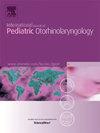唾液腺肉毒素注射是否需要超声引导?
IF 1.2
4区 医学
Q3 OTORHINOLARYNGOLOGY
International journal of pediatric otorhinolaryngology
Pub Date : 2024-09-17
DOI:10.1016/j.ijporl.2024.112114
引用次数: 0
摘要
方法在单中心研究中,不同资历的临床医生尝试对唾液腺进行盲注,之后在注射前通过超声引导确认其在腺体内或外的位置。结果2008年11月至2023年8月期间,117名患者接受了唾液腺肉毒素注射,共注射了459个腺体。其中 24 个(5%)腺体由医学生注射,32 个(7%)由初级受训人员(基础医生或高级住院医师)注射,343 个(75%)由注册医师或高级研究员注射,36 个(8%)由顾问注射。腮腺注射中有 160 次(68%)达到目标,颌下腺注射中有 74 次(32%)达到目标(P < 0.01)。结论:在唾液腺注射肉毒杆菌毒素时,无论医生的资历如何,都应推荐使用超声波引导。本文章由计算机程序翻译,如有差异,请以英文原文为准。
Does injection of botulinum toxin to salivary glands require ultrasound guidance?
Introduction
Injection of botulinum toxin into salivary glands is a well-established treatment for sialorrhea in children, but the absolute need for radiological guidance has not been tested.
Methods
Single-centre study in which clinicians of varying seniority attempted blind injection of salivary glands, after which their position within or outside the gland was confirmed by ultrasound guidance before the injection is administered.
Results
117 patients underwent botulinum toxin of salivary glands between November 2008 and August 2023, with 459 glands injected in total. 24 (5 %) glands were injected by medical students, 32 (7 %) by junior trainees (foundation doctors or senior house officers), 343 (75 %) by registrars or senior fellows and 36 (8 %) by consultants. 160 (68 %) of injections to the parotid gland were on target, and 74 (32 %) submandibular gland were on target (P < 0.01). No differences were detected on likelihood of success depending on seniority of practitioner, age of patient or hand dominance.
Conclusion
Ultrasound guidance ought to be recommended for injection of botulinum toxin into salivary glands regardless of the seniority of the practitioner.
求助全文
通过发布文献求助,成功后即可免费获取论文全文。
去求助
来源期刊
CiteScore
3.20
自引率
6.70%
发文量
276
审稿时长
62 days
期刊介绍:
The purpose of the International Journal of Pediatric Otorhinolaryngology is to concentrate and disseminate information concerning prevention, cure and care of otorhinolaryngological disorders in infants and children due to developmental, degenerative, infectious, neoplastic, traumatic, social, psychiatric and economic causes. The Journal provides a medium for clinical and basic contributions in all of the areas of pediatric otorhinolaryngology. This includes medical and surgical otology, bronchoesophagology, laryngology, rhinology, diseases of the head and neck, and disorders of communication, including voice, speech and language disorders.

 求助内容:
求助内容: 应助结果提醒方式:
应助结果提醒方式:


